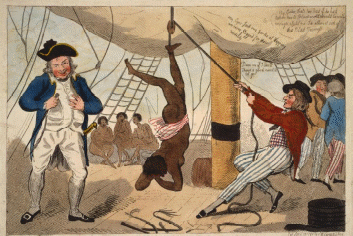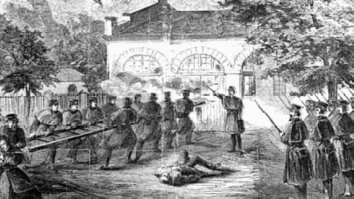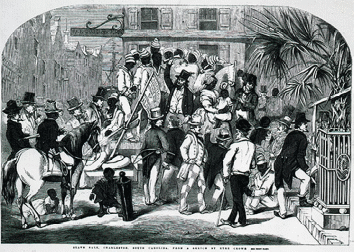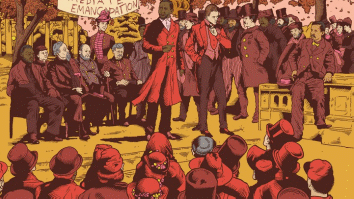The development of medieval slavery is a negative page in human history. Numerous destinies were crippled by the existing order due to the domination of one race over others and resulted in centuries of inequality as a generally accepted phenomenon. Individual empires with dozens of colonies around the world used free slave labour, which, in addition, was traded. Only in the 19th century, real attempts to change the existing order and provide freedom of captive immigrants began to be made. The activities of human rights defenders promoting the abolition of slavery started to spread globally, which made it possible to achieve positive results. Today, issues of inequality are discussed, but individual references to the events of past centuries allow demonstrating the inadmissibility of slavery as a phenomenon. The aim of this work is to find and discuss specific examples of slavery and attitudes towards it in the media, with an emphasis on historical events before the mid-19th century. A gradual shift in values was a turning point in the course of the abolitionist movement, but before its emergence, the oppression of people along ethnic lines was considered natural.
Torture and Violence as the Norms
One of the reasons confirming the inadmissibility of slavery and the unfairness of the attitude towards this phenomenon is the unjustification of torture and violence. People who were held in inhuman conditions and forced to hard work were not considered full members of society and were subjected to severe punishment for any attempt at disobedience or violation of detention conditions. Moreover, slave owners made no distinction between males, females and children and applied severe punishments to those who, in their opinion, behaved inappropriately. Rendal (2020) presents an image that vividly conveys the attitude towards slaves in the early 19th century. In Figure 1, a situation is depicted in which a black woman is hung on a rope on the deck of a ship, which implies punishing her for a certain offence (Rendal, 2020). This image demonstrates the full range of emotions, including the fear of other female slaves and the pleasure of the torturers.

This behaviour was not considered unnatural during the days of slavery, which was a good reason for abolitionists’ activities and the promotion of ideas about the protection of people held in inhuman conditions. Captives from Africa, South America and other colonies who were transported to Europe and America were treated as those who could endure any violence and survive torture as an essential element of slave education. This position reflects the unwillingness of society to accept the idea that equality and freedom are inalienable attributes that every person has the right to possess. Historical examples confirm that slavery was a phenomenon that was not geographically defined. As Spieler (2015) states, in some colonies, for instance, Guiana, there were no sugar or coffee plantations. Nevertheless, Europeans, in particular, the British, exported free labour from there in large quantities, which indicates the great commercial value of captives. To create stable and wide flows of slave trade routes, colonialists were brutal and showed unjustified cruelty. As a result, an inhumane attitude towards slaves became natural and was perceived as a logical principle of maintaining authority among vulnerable indigenous people in different colonies.
The idea that the slave trade was not limited by moral norms or social boundaries was supported at the official level. According to Rendal (2020), beginning in 1660, the British Crown gave the go-ahead for the supply of free labour from Africa to America, and there were no limits or forbidden rules. With world domination, the royal family had the authority to regulate the flow of the slave trade. There were no official documents or laws that coordinated the principles of keeping slaves since captives were not treated as people. This led to the fact that rudeness and cruelty were the key methods of interacting with them. Historical examples of mass executions, demonstrative punishments and other approaches to coercion into obedience were perceived as an essential attribute of domination. Spieler (2015) remarks that the attitude towards free labour was based on the idea that the nature of slaves did not imply high intelligence and was submissive to white colonists. Therefore, torture and violence that were used against captive immigrants from Africa and other regions were perceived as a social norm and promoted as a logical aspect of coercion into submission.
Early Attempts to Change Mass Consciousness
Although slaves had no opportunities to express their positions and defend their rights in other ways than uprisings, any attempts to regain freedom were brutally suppressed. Since the slave trade flourished during the era of colonisation, control over captives was tough, and immigrants from Africa and other colonies did not have a chance to organise squads and groups to counter the violent regime. However, despite this order, individuals among the general white population began to promote ideas of humanism and made attempts to change public opinion about the inadmissibility of slavery. These figures called themselves abolitionists and sought to legitimise the ban on human trafficking. Their activities were underground since their ideas contradicted with the existing social and legal norms and were considered extremist. In Figure 2, an example is shown of an armed troop attacking the home of John Brown, one of the well-known abolitionists (De Togni, n.d.). One can assume that the local authorities were afraid of shifts in the mass consciousness and were ready to go to great lengths to suppress riots. Thus, stopping illegal activities to organise uprisings and create resistance movements was a critical task.

Neither slave owners nor government officials were ready for society to abandon the idea of inequality and accept humanistic views as the key principles of interaction. As De Togni (n.d.) states, in a number of colonial countries, local industries were largely dependent on the slave trade. The author cites the example of Boston in which the textile industry was one of the leading spheres and developed due to the work of free labour (De Togni, n.d). However, the abolitionist views that emerged in this region threatened the production process significantly. At the same time, protest sentiments began to manifest in other places where the authorities had to make severe efforts to prevent riots, for instance, in Washington that was the centre of American power (De Togni, n.d.). According to Baszile (2015), the first serious attempts to change the mass consciousness began in 1776 after the signing of the American Declaration of Independence. Human rights defenders sought to create a society with equal rights and opportunities, which was unacceptable under the existing order of legal inequality. Thus, the end of the 18th century became a turning point for the slave system.
The late 18th and early 19th centuries were the stages when the activities of abolitionists began to spread among the masses. Baszile (2015) argues that after America gained independence from the British Crown, local movements in support of equality and the abolition of slavery became widespread. However, those stakeholders who were not ready to abandon the slave trade as a key resource for enrichment took strong measures to curb any attempts to change the situation. As a result, abolitionists had to act covertly, and underground activities to prepare measures to combat the existing order was the only possible approach. As De Togni (n.d.) remarks, human rights defenders had to rely on their own forces and resources since any association with representatives of the movement in other countries was impossible due to total control. However, abolitionists succeeded in achieving their initial goals: society began to pay attention to the problem of slavery. Certain categories of the population accepted the idea that inequality supplemented by cruelty, violence and torture could not exist in any form. Therefore, the first shifts in mass consciousness were achieved due to abolitionists’ activities.
Shift in Values
In Britain, the abolitionist movement began a little earlier than in America. In the 1760s, the first attempts were reported by both white and black activists to draw public attention to slavery as an unacceptable phenomenon (“How did the Abolition Acts of 1807 and 1833 affect,” n.d.). Opportunities to influence European colonists expanded due to the constant influx of new members to this movement. In society, alliances of white and black citizens became widespread, and Figure 3 depicts a gathering of people with the representatives of two races (“How did the Abolition Acts of 1807 and 1833 affect,” n.d.). Such an outcome was unlikely in the 18th century when colonisation was one of the key directions of trade and highly valued as the most important channel for replenishing the treasury and achieving world domination. However, at the turn of the century, a shift in values under the influence of the abolitionist movement became apparent, and specific measures were taken to combat inequality. The participation of human rights defenders paid off and proved that the idea was perceived positively among a large number of people who sought to change social norms.

The influence of abolitionists on masses became significant, and an increasing number of people joined their movement. As a result, in 1807, the British Parliament passed the Act of the Abolition of the Slave Trade that promote social equality (“How did the Abolition Acts of 1807 and 1833 affect,” n.d.). According to Woods (2015), planters and slavers did not share the triumph of abolitionists, and the Act was not passed unequivocally. Moreover, among some stakeholders, discontent was expressed strongly since, in addition to financial opportunities they lost, they faced a position that contradicted their views on the existing social order. However, the empathy of abolitionists for slaves made it possible to change the consciousness of the ruling elites, which can be interpreted as a significant advance in the fight against slavery. As Woods (2015) argues, this achievement was valuable not only from the standpoint of strengthening moral values. Former slave traders received no material incentives or other resources as compensations for the loss of their business. This, in turn, became one of the steps towards the establishment of democracy and class justice, what was contrary to the current immoral norms.
Despite the changes, the complete abolition of slavery had not been achieved yet. Numerous conventions that developed over a long period prevented the immediate end of the free labour trade. According to Woods (2015), in 1807, the abolitionist campaign was successful, but initially, the Act aimed to limit the economic interests of France. Subsequently, the British authorities implemented the provisions of the Act within the state, but foreign economic interest was one of the significant drivers. At the same time, the value of the measures taken by the government allowed rooting the idea that slavery was unacceptable from either a social or an ethical perspective. One of the main abolitionists’ achievements was the shift in values and the acceptance of the idea of the need to replace the vector of development from the slave trade to other industries. The beginning of the 19th century was marked by a transition from decades of oppression of immigrants from Africa and other poor regions to more advanced and morally justified principles of a democratic society. The interim success became a significant factor stimulating subsequent developments in this direction and further abolitionists’ achievements.
Differences in Views Before the Total Abolition of Slavery
The analysis of the situation after the Act of 1807 can provide an opportunity to determine the key moods in society and, in particular, the attitude towards slavery as a phenomenon considered ambiguous and controversial. Media examples confirm that most of the resources focus on abolitionist ideas aimed to denigrate slave traders. There is no indication that human trafficking was justified from a financial, ethical, geopolitical or another perspective, which suggests a clear view of the issue at hand. For instance, in Figure 4, a meeting of respected citizens is presented where problems related to slave emancipation are resolved (Rothman, 2016). One should take into account that not only white citizens are present in this image but also several black ones, which confirms a significant shift in mass consciousness regarding the rights of the black population. However, not all the strata of society were unambiguous about the abolition of slavery, which was logical in the face of financial losses for a number of interested parties. Nevertheless, the share of these representatives in power was minimal, which made it possible to promote the ideas of emancipation at the global level successfully.

Views on abolitionism in the media prove that the trend towards changing societal ideas about slavery was supported early and continues today. Dolan (2017) argues that the Slave Emancipation Act adopted in 1833 became one of the key documents regulating the formal British refusal of human trafficking. However, some media sources cite controversial opinions of the opponents of abolitionism. Rothman (2016) cites critics who noted that minority rights activists focused on one issue while ignoring others. In particular, the author notes that some citizens disputed the unambiguity of the ideas of abolitionists and stated that they were inclined to fight only against slavery (Rothman, 2016). Other manifestations of the bourgeois-capitalist system, according to this standpoint, were not addressed. Nevertheless, such an opinion could be justified if public figures strove for insignificant or meaningless goals. However, as Dolan (2017) remarks, the end of the colonial era and slave emancipation may be considered the most important achievements of humanity in the 19th century. Therefore, the criticism of the abolitionist movement can be regarded as lacking sufficient grounds.
Before slavery was completely eradicated as a social phenomenon, certain classes and even regions expressed disagreements with the results of the struggle against the current system. Rothman (2016) draws attention to the economic decline that the southern regions of America faced after the free labour supply stopped. In addition, social issues regarding the freedom of Africans who had no personal belongings also remained open. However, despite the disagreement of individual classes, emancipation at the legislative level was inevitable. As Dolan (2017) notes, in the British colonies in the West Indies, measures were taken to ensure a relatively slow transition to the new order. This principle of ensuring the security of all parties involved indicates the interest of the authorities in pursuing the emancipation policy as efficiently as possible since this issue was a key problem in society. Given potential tensions in economic and trade sectors, states needed to promote systems of strategic cooperation. As a result, emancipation is not considered as a negative consequence of abolitionism and can be assessed as a logical and ethically correct total of many years of abolitionists’ activities.
General Principles of Reflecting Slavery in Media Sources
Starting from the analysis of various representations of slavery in the media based on graphic images and opinions, one can note that the key ideas are reduced to abolitionism as an inevitable social phenomenon. The position justifying slavery cannot be acceptable in modern democratic society since ethics in human relationships largely determine the nature of interactions. At the same time, many resources mention the dissatisfaction of certain classes with the abolition of slavery. According to the review, the main complaints against abolitionists are reduced to an emphasis on human trafficking and ignoring other issues that deserve attention. Nevertheless, while taking into account a long mechanism for the abolition of slavery, which implied many years of preparation, the results of legislative practice were positive. Thus, the main trends reflecting slavery in the media are based on the condemnation of such a social order and a positive assessment of abolitionists’ activities.
Conclusion
The comprehensive assessments of media resources highlighting the topic of long-term slavery and visual content reflecting the social moods of that time prove that Africans captured by slave traders were significantly oppressed. The absence of democratic freedoms was characteristic of the 18th-century society, and it was only in the 19th century that real shifts in values began to be observed. However, the activities of abolitionists seeking to stop slavery and fighting for equality started to spread globally before the adoption of the relevant laws. The analysis of media sources shows that the discontent of certain classes of the population had financial grounds. The criticism of the abolitionist movement presupposed the condemnation of too narrow legal work. However, due to the joint efforts of human rights defenders and legislators, the corresponding acts on democratic rights were signed, which marked the beginning of the new era of social relations.
References
Baszile, D. T. (2015). Rhetorical revolution: Critical race counterstorytelling and the abolition of white democracy. Qualitative Inquiry, 21(3), 239-249.
De Togni, E. (n.d.). Martyrdom through militancy and the onset of Civil War.American Battlefield Trust. Web.
Dolan, E. A. (2017). Lionel Smith in Barbados, 1833–1836: Imperialist and abolitionist rhetoric in emancipation-era Caribbean governance. Slavery & Abolition, 39(2), 333-356.
How did the Abolition Acts of 1807 and 1833 affect the slave trade? (n.d.). Web.
Rendal, S. (2020). When was slavery abolished in the UK? Britain’s role in the slave trade outlined following the removal of Edward Colston’s statue.The Scotsman. Web.
Rothman, A. (2016). The truth about abolition: The movement gets the big, bold history it deserves.The Atlantic. Web.
Spieler, M. (2015). Slave flight, slave torture, and the state: Nineteenth-century French Guiana. French Politics, Culture & Society, 33(1), 55-74.
Woods, M. E. (2015). A theory of moral outrage: Indignation and eighteenth-century British abolitionism. Slavery & Abolition, 36(4), 662-683.